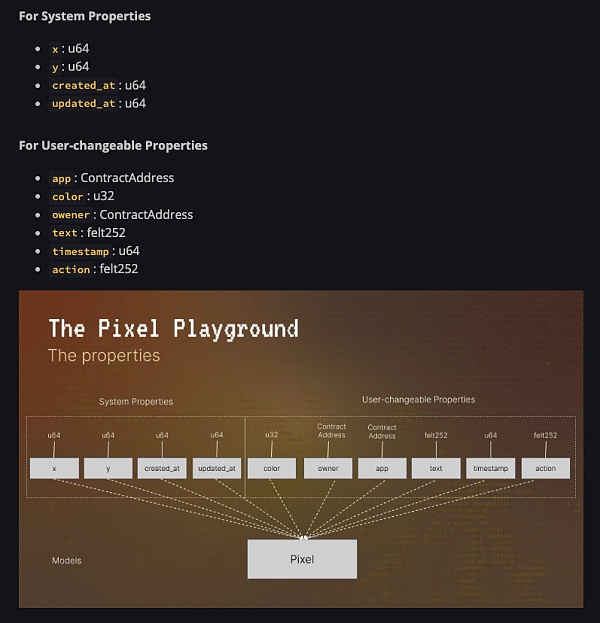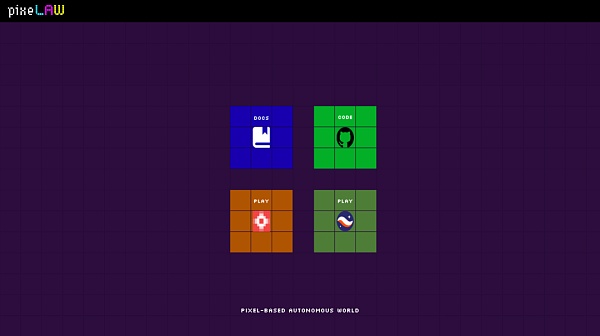Author: ck
Autonomous World and Minimal Rule Set

Image source: https://ethglobal. com/showcase/pixelaw-kvnqe
PixeLAW is an autonomous world dedicated to exploring interoperability between games, born During the ETHGlobal Paris Hackathon in July 2023, it won the first prize of Starknet Best Use. PixeLAW is built on a full-chain game engine and is committed to exploring the potential value of interoperability between games. It has the native characteristics of blockchain such as permissionless and composable, and thus builds an autonomous world.
There have been quite a few explanations for the autonomous world, such as: "digital" planets, infinite games, on-chain "reality", etc. To me, an autonomous world is anopen world with no fixed tasks or goals, only emergent, random events, just like everything that is happening in the physical world , but it has a set of sufficiently concise and immutable rules, referred to as Minimum Rule Set.
EVM as a minimal rule set

Image source: https://unsplash.com/photos/a-black-background-with-red-and-white-lines-pyt6ZAHfmx4
From the perspective of the minimum rule set, Ethereum (here refers to all EVM-compatible chains and the large Ethereum ecosystem composed of all Ethereum Layer 2) is a typical " Autonomous World”! Its minimal rule set is "EVM". Anyone can deploy arbitrary code into the "world" as long as they follow this set of rules (coded in Solidity). In other words, everything that happens in this world is spontaneous, permissionless, and random.
“Pixel” as a minimum rule set
"Pixel" is the smallest programmable unit in PixeLAW and the smallest rule set of PixeLAW It consists of 6 programmable attributes: App, Color, Owner, Text, Timestamp, and Action. Developing games on PixeLAW is to program the six attributes of Pixel. This is the only "restriction" and the only "physical law" of this autonomous world.

Source: https://pixelaw.github.io/book/architecture/overview.html
Advantages of PixeLAW as an autonomous world
Creative freedom unlocked by a minimal ruleset
You can create any game on PixeLAW as long as you follow a minimal set of rules:
Use Rock, paper, scissors with one Pixel,
Snake using two Pixels,
Use three Pixels to guess numbers,
Use nine Pixels to play Tic-Tac-Toe, Minesweeper, 2048, Sudoku, Puzzle, and Puzzle Games And more,
Use more of Pixel's music score co-creation, chess, Monopoly games, and more.

Image source: https://twitter.com/0xPixeLAW/status/1737096643952922907
Full-chain game client freedom
Since the logic and status of the full-chain game are all stored on the chain, it releases Provides greater game client freedom. Taking PixeLAW as an example, its client can be not limited to pixel style, but can also be voxel style; it can be not limited to PC, or it can be mobile; one client can host all games, or one client can only play games. Hosting a specific game or games). In short, PixeLAW is client-free (in theory, all applications on the chain are client-free).
Developer friendly
Because PixeLAW is excellent Designed and engineered to be very developer friendly. To put it simply, to develop games on PixeLAW, you only need to complete contract development, and PixeLAW will take care of contract deployment, front-end development, UI design and other matters for you.
Vice versa, if you are only good at front-end development and lack experience in contract development, you can still develop a game with more features for the existing games in PixeLAW A client with a good UI, or just integrate multiple games in PixeLAW to build a new game through a pure front-end approach.
Metagame as a case for composability
"Pixel " is the smallest rule set of PixeLAW and the smallest programmable unit in PixeLAW. Building a game on PixeLAW is to programmatically combine one or more "Pixels" (similar to programmable Lego bricks).
You can also programmatically combine games that others have built on PixeLAW to build your own game. In this way, you will get a game on top of a game, which is also one of the "meta-game" exploration paths. In the same way, others can also combine the games you have built through programming to get a new game for them. This continuous cycle, stacking, and integration is the path to the evolution of PixeLAW's composability, and it is also the path to PixeLAW's meta-game practice.
To sum up,PixeLAW brings the practical path of the independent world, the practical path of creation on the free chain, and the realization path of full-chain game client freedom , Composability practice path based on metagame. Whether for developers, creators, players or the entire blockchain application ecosystem, it deserves more attention and practice.
PixeLAW as a multi-chain application
Based on the above reasons, We believe that PixeLAW exists in more blockchain ecosystems and is a better solution to maximize its value. Prior to this, PixeLAW only existed in the Startnet ecosystem (developed based on the Dojo engine). Although Startnet is the second layer of Ethereum, due to its unique technical route (ZK Rollup and Cairo language), it is not suitable for the majority of EVM ecosystem developers (using Solidity language) is not friendly.
Therefore, we (MetaCat) are building an EVM-compatible version of PixeLAW based on the MUD engine, bringing PixeLAW to the pan-EVM ecosystem, and working with the largest developer group of Web3 , let’s explore the infinite possibilities of the autonomous world as the latest application of blockchain.
You can view PixeLAW based on Dojo and MUD by visiting the PixeLAW official website pixelaw.xyz. We also look forward to everyone exploring more interesting cases based on PixeLAW, and PixeLAW implemented on other heterogeneous blockchains (such as Bitcoin, Solana).
Essentially, PixeLAW is a methodology for realizing an "autonomous world" on the blockchain, which can be used in any block There are arbitrary implementations on the chain.

PixeLAW official website: https://www.pixelaw.xyz/
Autonomous World and Web3 Ecology
As mentioned above, the Ethereum ecosystem can be regarded as an "autonomous world". In the same way The Bitcoin ecosystem can also be regarded as an "autonomous world". Taking a step further, we can also regard the large blockchain ecosystem composed of the Ethereum ecosystem + the Bitcoin ecosystem, let's call it Web3 (although it is not accurate, but it is enough to describe its core) as a larger autonomous world. In this sense, the autonomous world is the same macro concept as Web3, and can also be the ultimate goal of blockchain practitioners!
At this level, is it the account balance model of Ethereum, the UTXO model of Bitcoin, the homogeneous token based on ERC-20, or the UTXO model of Bitcoin? Is a fungible token based on BRC-20 a non-fungible token based on ERC-721 or a non-fungible token based on Bitcoin Ordinals? Is it based on the Bitcoin Metaverse based on Bitmap theory? There is no so-called portal dispute in the ERC-standard Ethereum Metaverse (whether in terms of technical routes, consensus solutions, governance models, or other aspects). Because all of this is: the natural emergence in the large "autonomous world" of the blockchain, and these emergences together constitute the autonomous world.
 JinseFinance
JinseFinance
 JinseFinance
JinseFinance JinseFinance
JinseFinance JinseFinance
JinseFinance Miyuki
Miyuki Medium
Medium Vitalik
Vitalik
 Cointelegraph
Cointelegraph Ftftx
Ftftx Cointelegraph
Cointelegraph